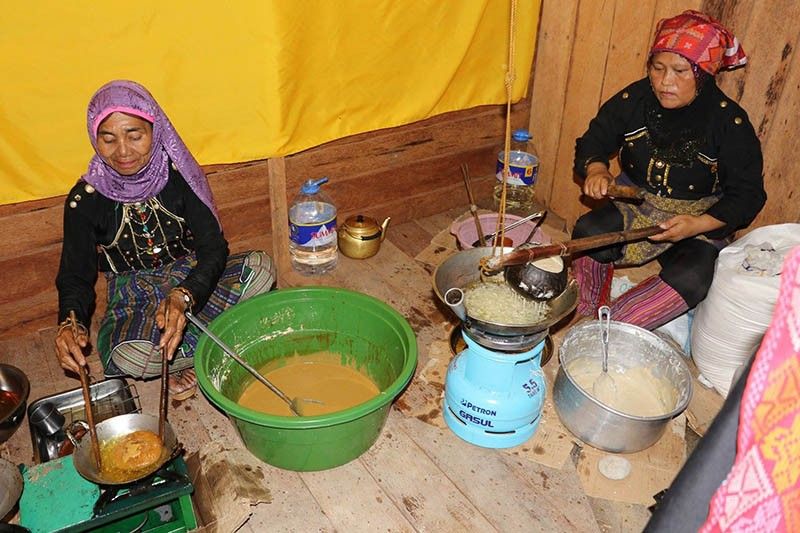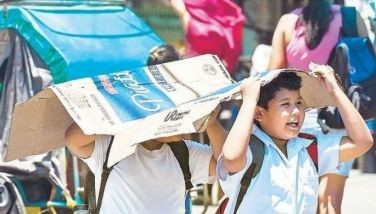Ethnic villages showcase cultures, traditions of 5 tribes in ARMM

COTABATO CITY, Philippines — The local communities are learning a lot on the ethnicity of the original southern inhabitants from mock villages in the capitol here of the Autonomous Region in Muslim Mindanao.
The Yakan, Tausug, Sama, Meranao and Maguindanaon ethnic villages inside the 32-hectare ARMM compound here also showcases the cultural practices of each of the five tribes particularly those on propagation of peace, cultural and religious solidarity, commerce and trade.
More than 2,000 local tourists, college and high school students and elementary pupils accompanied by teachers have visited the ARMM capitol in the past five days to see the temporary villages.
ARMM’s regional education secretary, lawyer Rasol Mitmug Jr., said Sunday the Meranao model village, where he is chieftain, also showcases tribal cuisine that the Meranaos, also known as “people of the lake,” have preserved for centuries.
The Meranao village has makeshift buildings patterned from those that existed in Marawi City before it was ruined by last year’s five-month siege by combined Maute and Abu Sayyaf terrorists.
The conflict left more than a thousand people dead, among them military and police personnel, and displaced no fewer than 300,000 villagers.
There is a public stage at one side of the Meranao village patterned from the Plaza Cabili in Marawi City, where cause-oriented rallies and political sorties were held before.
Beside the Meranao village is the Yakan enclave, where visitors could watch women weaving the colorful Yakan fabric using handlooms.
The Yakan village has a traditional “lumah,” which means house in the Yakan dialect, with roof made of dried cogon leaves.
The Yakan village, led by a designated sultana, ARMM’s regional executive secretary, the registered nurse and lawyer Laisa Masuhud-Alamia, also has a masjid (worship site).
Its masjid is a replica of those existing in remote barrios in the island province of Basilan.
The Sama, Tausug and Maguindanaon villages all depict the cultural identities, architectures and arts of each tribe.
The Maguindanaon village also highlights the presence in Maguindanao province of ARMM’s indigenous non-Moro Teduray people thriving in the highland Upi and South Upi towns.
The Sama village has structures projecting Tawi-Tawi province as the country’s southern front door, gateway to Brunei and Malaysia.
It has an iconic mosque that looks like the one built by Arab missionary Sheik Karimul Makdum.
Makdum set foot in Bohe Indangan in what is now Simunul island town in Tawi-Tawi during the 14th century to preach Islam that eventually spread through nearby Sulu, homeland of the Tausugs, to Basilan and the Zamboanga peninsula.
The setting up of the mock ethnic villages is a project of the office of ARMM Gov. Mujiv Hataman, as showcases of the cultures and traditions of the natives in the region’s five provinces --- Maguindanao and Lanao del Sur, both in mainland Mindanao, and the islands of Basilan, Sulu and Tawi-Tawi.
The mock villages were launched last June 18 as part of this year’s ARMM Pakaradjaan Festival, to culminate during the commemoration of the region’s 29th founding anniversary in November this year.
The ARMM, which has a charter, the Republic Act 9054, was created as an answer to the quest of southern Moro communities for self-governance.
Its regional government has an executive department under the Office of the Regional Governor, touted as ARMM’s “Little Malacañang,” and a 24-seat Regional Assembly, comprised of three representatives from each of the region’s eight congressional districts.
There is a possibility that the ARMM could be replaced with a Bangsamoro regional entity if the Bangsamoro Basic Law, subject to final deliberation in July by the bicameral committee of the House of Representatives and the Senate, is approved and ratified via a plebiscite.
The BBL was drafted by representatives from the government and the Moro Islamic Liberation Front based on two compacts between Malacañang and the MILF, the 2013 Framework Agreement on Bangsamoro and, subsequently, the 2014 Comprehensive Agreement on Bangsamoro.
The draft BBL is a product of 17 years of peace talks between the government and the MILF.
Hataman and members of his regional cabinet have been vocal in endorsing the BBL, which is for them a lasting solution to the Moro secessionist issue hounding southern Mindanao since the late 1960s.
- Latest
- Trending



























